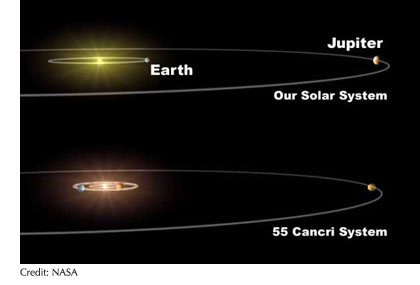|
 With
the discovery of a fifth planet orbiting the star 55 Cancri, a team of
scientists including SF State astronomers are one step closer to demonstrating
that planets capable of sustaining life as we know it may exist beyond
our own solar system. Assistant Professor of Astronomy Debra Fischer and
Adjunct Professor Geoffrey Marcy discussed the planet hunting team's newest
findings at a November 6 teleconference hosted by the National Aeronautic
and Space Administration (NASA) Jet Propulsion Laboratory. A paper on
the topic authored by Fischer, Marcy and colleagues was accepted for publication
in Astrophysical Journal. With
the discovery of a fifth planet orbiting the star 55 Cancri, a team of
scientists including SF State astronomers are one step closer to demonstrating
that planets capable of sustaining life as we know it may exist beyond
our own solar system. Assistant Professor of Astronomy Debra Fischer and
Adjunct Professor Geoffrey Marcy discussed the planet hunting team's newest
findings at a November 6 teleconference hosted by the National Aeronautic
and Space Administration (NASA) Jet Propulsion Laboratory. A paper on
the topic authored by Fischer, Marcy and colleagues was accepted for publication
in Astrophysical Journal.
The astronomers say that striking similarities between the 55 Cancri system
and our own demonstrate that the Milky Way probably contains many other
systems like the Earth's solar system.
"One of the most interesting things about this planetary system is
that it has more giant planets than our own solar system," said Fischer.
"Like our own solar system, we see signs that it is packed with planets."
Four of the 55 Cancri planets exist within a habitable zone, an area close
enough to the star to maintain temperatures that sustain water in liquid
form.
"We haven't yet found a twin of our solar system because the four
planets close to the star are all the size of Neptune or bigger,"
said Marcy, who is also a professor of astronomy at University of California,
Berkeley. "But finding five extrasolar planets orbiting a star is
a significant step."
"Our team has been following this star for 18 years and gradually
finding one and then another planet. It's been three years and 200 additional
trips to the Observatory since the fourth planet was found," said
Fischer. "Now, we’ve identified a fifth. How many more are
there? Is there a giant moon around this latest planet that might have
an atmosphere and pools of water?"
The newly discovered planet is fourth in succession from 55 Cancri, which
is 41 light years away from Earth and located within the constellation
known as Cancer. Astronomers expect that the planet, which is about half
the mass of Saturn, has a substantial core and a thick atmosphere. The
planet takes 260 days to orbit its star, similar to the time it takes
Venus to orbit the Sun.
The three planets closest to 55 Cancri complete circular orbits with "years"
that range from about three to 44 days and traveling distances between
3.5 million miles and 22.3 million miles. The planet farthest from its
star is about the size of Jupiter and completes its orbit every 14 years,
traveling a distance of 539.1 million miles. Existing well outside the
habitable zone, it is the only known Jupiter-like gas giant planet to
reside as far away from its star as our own Jupiter.
Since 1995, when the first extra-solar planet was discovered by the team,
more than 250 planets have been detected orbiting other stars. The team
tracks the velocities of almost 2000 stars. Stars with planets will wobble
back and forth, changing speed as the star moves toward and away from
Earth. The changes in speed are caused by the gravitational pull of the
planets, with which the star orbits a common center of mass. Fischer noted
that in our own solar system, Jupiter causes the Sun to wobble with a
speed of 12 meters per second, easily detectable with high-precision velocity
measurements.
"This is an exciting next step in the search for worlds like our
own," said Michael Briley, an astronomer and program manager at the
National Science Foundation, who along with NASA, has funded the team's
research. "To go from the first detections of planets around sun-like
stars to finding a full-fledged solar system with a planet in a habitable
zone in just 12 years is an amazing accomplishment and a testament to
the years of hard work put in by these investigators."
Additional members of the team and co-authors of the paper are (SF State
alum) Paul Butler of the Carnegie Institution of Washington, who with
Marcy developed the computer software for detecting planets, and Steven
Vogt of the Lick Observatory and University of California, Santa Cruz,
who built the spectrometers used. Authors also included Greg Laughlin
from the University of California, Santa Cruz; Greg Henry of Tennessee
State University; David Abouav, Chris McCarthy and Howard Isaacson of
San Francisco State University; Kathryn Peek, John J. Johnson and Jason
T. Wright of the University of California, Berkeley.
The
team's findings were based on observations made with the Shane telescope
at the Lick Observatory located on Mt. Hamilton east of San Jose and operated
by the University of California, and the W.M. Keck Observatory in Mauna
Kea, Hawaii, operated by the University of California and the California
Institute of Technology.
For more information, visit:NASA's News Releases
.
For illustrations and streaming audio of the teleconference, visit NASA's News Audio Live Streaming Web site.
-- Denize
Springer
 |
